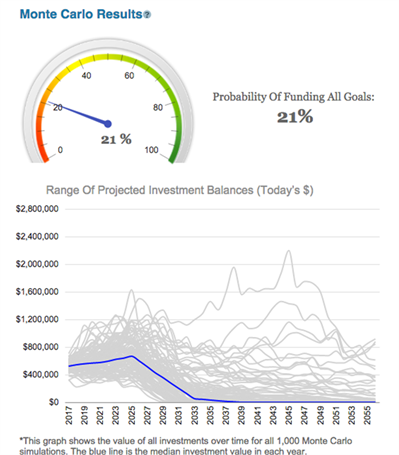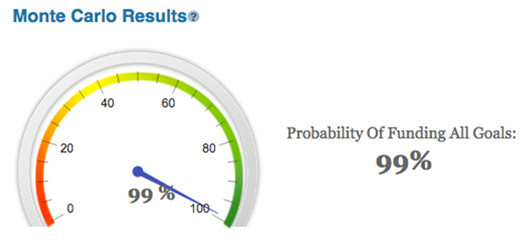Key Points:
- Fixed income doesn't get you as far as it used to.
- A portfolio of higher-yielding stocks with growing dividends can mean you never need to draw down on your principal.
- Moving a larger portion of your investment funds into stocks at or near retirement could lead to more volatility than you might like, but the result can be worth it.
One definition of a worry-free retirement is not having to worry about where the money is coming from. As I have written before, "You are truly retired (or able to retire) when your passive income covers your expenses."
If you're extraordinarily wealthy, you can simply draw down on your principal for income, and not worry about where it's invested. If it's in the stock market, and there's a big correction, that's OK; if it's in a low-risk fixed-income account barely (or not even) keeping up with inflation, that's OK too. Because the principal is so large, it doesn't really matter where the funds are invested. You'll be fine either way.
But most of us aren't in that boat. In fact, just the opposite: we are concerned that we don't have enough principal in the first place, and we're unsure if we can safely draw down from it very much in retirement.
For those with less-than-unlimited resources, there's another way to make this work. You'll still need an investment portfolio. And probably to a large extent, it will need to be in stocks. But if you set it up correctly, you won't need to take any principal at all--or not very much, anyway.
Things Ain't What They Used To Be
Ten years ago, you could have generated around 5% income from 10-year treasury notes--about as safe an investment available. Today's yield on treasuries is about half that. So we need a stronger income-generating investment vehicle.
It's easy to understand why. A million-dollar portfolio invested in 10-year treasuries in 2007 could have generated $50,000. Today it would be more like $25,000. Meanwhile, it's not like living expenses in retirement have gone down by half in the past ten years. What will we do to make up the difference?
One way to generate more income in retirement is to invest in real estate and use rental income in lieu of interest payments from bonds. My other recommendation will not be a surprise to regular readers: Dividend payers and dividend growers.
Although stocks have been on quite a tear, you can still build an equity portfolio--across a number of sectors--made up of companies that pay solid, growing dividends, and that have done so for years. If you can . . .
- Build a decent-sized portfolio
- Take on a bit more volatility in your portfolio than you might be used to
- Get a good handle on your spending needs in retirement
. . . then you should be able to live off of the dividends, and not draw down on the principal at all (or at least not depend on that principal).
Let's have a look at a potential portfolio for such a plan.
| Company | Ticker | Yield | Annual Dividend Growth (5-Yr) | Consecutive Div Increase (Years) |
| AT&T | T | 4.6% | 2.2% | 33 |
| Chevron | CVX | 3.8% | 6.8% | 29 |
| Coca-Cola | KO | 3.4% | 8.3% | 54 |
| National Grid | NGG | 5.2% | 3.1%* | 25* |
| National Retail Properties | NNN | 4.2% | 3.1% | 27 |
| Southern Co | SO | 4.6% | 3.5% | 16 |
| Welltower | HCN | 5.2% | 3.9% | 13 |
| Vector Group | VGR | 7.0% | 4.2% | 19 |
| VF Corp | VFC | 3.0% | 18.6% | 44 |
| Averages | | 4.6% | 6% | 29 |
*Local currency. Data as of January 31, 2017.
Here we have a diversified portfolio of nine companies, with an average yield of 4.6%, boosting their payouts year in and year out, sometimes for decades, and by 6% annually on average for the past few years.
What does this mean? It means we can get close to those 2007 treasury yields, for one thing. And these are just some of the potential companies for building such a portfolio. There are plenty of others.
Of course, with any stock portfolio, you'll need to be prepared for some volatility. It won't be the same level of volatility you would see in the overall stock market, but it will certainly be more than you would see with a portfolio of treasuries.
For the most part, though, you should not care about that volatility. As long as the dividends keep coming, you'll be right where you want to be.
Meet Ralph and Kim
Let's look at an example. A 50-year-old couple with about $500,000 in invested assets is trying to figure out if they are on track to retire in 10 years. They expect to spend around $60,000 a year once retired, and don't want to take Social Security until they are at full retirement (67), when they can get the maximum benefit from it.
The couple figures they'll invest in a 50/50 split of growth stocks and value stocks up until retirement, and then, as is often done, shift to a more conservative allocation once they get to retirement. For simplicity's sake, we're assuming a single, taxable brokerage account for their investable assets.

Here's how this plan looks when we put it through the Monte Carlo simulation:

WealthTrace lets you specify returns before retirement and returns after retirement. Learn more.
Things aren't looking so good for this couple. They actually have a decent amount of money coming in once Social Security starts, but with this plan, they'll likely run out of money before then.
What to do? Well, the portfolio above is one solution. Remember, that portfolio should generate an annual yield in the 4.6% range. Not only that, those dividends should grow about 6% annually, on average.
But we don't want to put our couple in that portfolio until they retire. Until then, we want them to get the benefit of compounding returns in their 50/50 value-and-growth-stock portfolio.
So, first, we need to estimate what that the value of the portfolio will look like at retirement when we move them into that allocation. We're assuming a fairly conservative 7% annual return right now, but it's not conservative enough for this purpose. We simply can't count on 7% market returns, year in and year out, for any 10-year stretch. A bear market or a recession, especially early on, could blow that up.
Knocking that annual return down to 5% annually (while still assuming an $8,000 annual contribution) gives us a balance at retirement of about $650,000:

Our next step, then, is to enter an annual cash flow of $30,000, starting at retirement. That's 4.6% on our $650,000 portfolio.
 With WealthTrace, you have complete control over projected cash flows, their growth rates, and the expected tax on them. Learn more.
With WealthTrace, you have complete control over projected cash flows, their growth rates, and the expected tax on them. Learn more.
So, to recap, we:
- Give our assumed straight-line annual return for the next 10 years a haircut, from 7% to 5%
- Assume dividends on the $650,000 portfolio of 4.6%, or $30,000 annually, growing 6% annually, and taxed at 15%
- Assume the remaining total return on the portfolio (capital gains) after retirement will be 2% annually
And once we do that . . .

That's more like it.
Having a larger percentage of your portfolio in stocks at retirement than what conventional wisdom says is normal needn't be scary. With the right stocks, a decent-sized nest-egg, and a solid grip on your spending needs, it could be your best move.
What would increasing your savings rate or investing in different asset classes do to your retirement plan? Could you handle a stretch of stock-market volatility? WealthTrace can help you find out. See how making changes to your investments affects the probability of your plan succeeding. Click here to learn more.